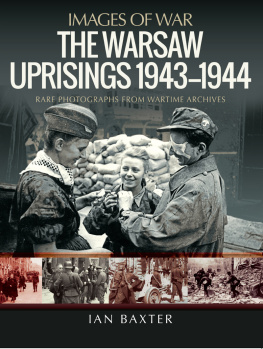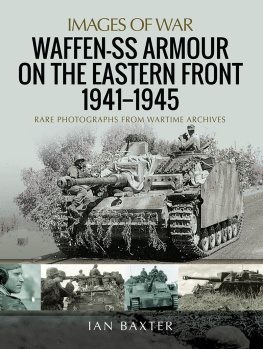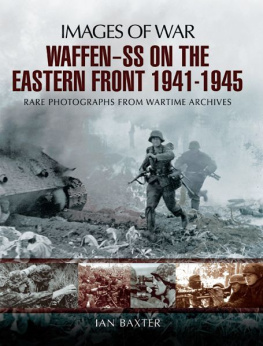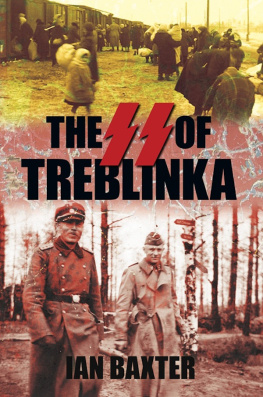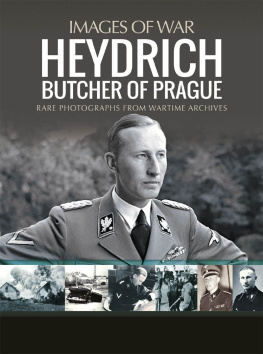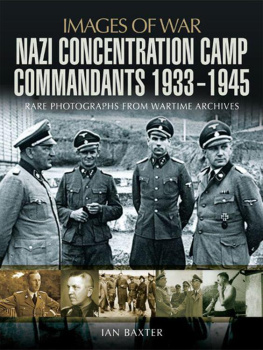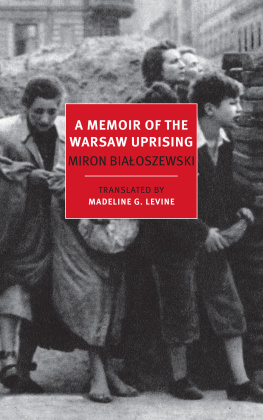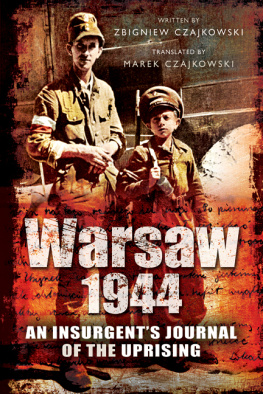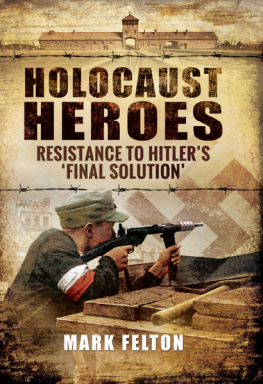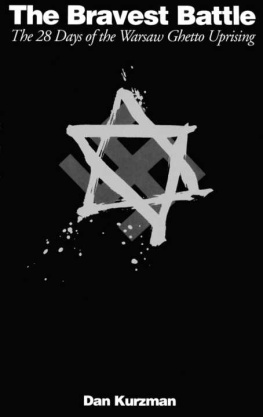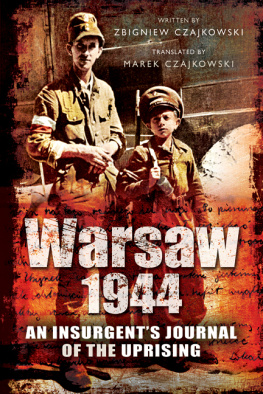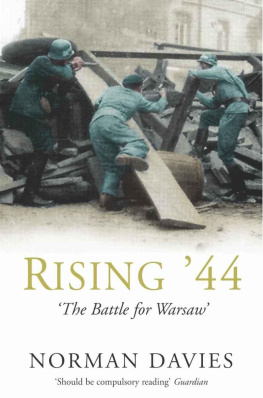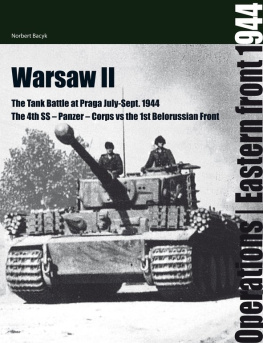Pagebreaks of the print version
IMAGES OF WAR
THE WARSAW UPRISINGS 19431944
RARE PHOTOGRAPHS FROM WARTIME ARCHIVES
Ian Baxter
First published in Great Britain in 2021 by
PEN & SWORD MILITARY
an imprint of
Pen & Sword Books Ltd
47 Church Street
Barnsley
South Yorkshire
S70 2AS
Copyright Ian Baxter, 2021
ISBN 978-1-52679-991-3
eISBN 978-1-52679-992-0
Mobi ISBN 978-1-52679-993-7
The right of Ian Baxter to be identified as author of this work has been asserted by him in accordance with the Copyright, Designs and Patents Act 1988.
A CIP catalogue record for this book is available from the British Library.
All rights reserved. No part of this book may be reproduced or transmitted in any form or by any means, electronic or mechanical including photocopying, recording or by any information storage and retrieval system, without permission from the Publisher in writing.
Pen & Sword Books Limited incorporates the imprints of Atlas, Archaeology, Aviation, Discovery, Family History, Fiction, History, Maritime, Military, Military Classics, Politics, Select, Transport, True Crime, Air World, Frontline Publishing, Leo Cooper, Remember When, Seaforth Publishing, The Praetorian Press, Wharncliffe Local History, Wharncliffe Transport, Wharncliffe True Crime and White Owl.
For a complete list of Pen & Sword titles please contact
PEN & SWORD BOOKS LIMITED
47 Church Street, Barnsley, South Yorkshire S70 2AS, England
E-mail:
Website: www.pen-and-sword.co.uk
Dedicated to the brave souls
who fought and died
during the Warsaw rebellions
About the Author
I an Baxter is a military historian who specialises in German twentieth-century military history. He has written more than fifty books including Poland The Eighteen Day Victory March, Panzers In North Africa, The Ardennes Offensive, The Western Campaign, The 12th SS Panzer-Division Hitlerjugend, The Waffen-SS on the Western Front, The Waffen-SS on the Eastern Front, The Red Army at Stalingrad, Elite German Forces of World War II, Armoured Warfare, German Tanks of War, Blitzkrieg, Panzer-Divisions at War, Hitlers Panzers, German Armoured Vehicles of World War Two, Last Two Years of the Waffen-SS at War, German Soldier Uniforms and Insignia, German Guns of the Third Reich, Defeat to Retreat: The Last Years of the German Army At War 194345, Operation Bagration the Destruction of Army Group Centre, German Guns of the Third Reich, Rommel and the Afrika Korps, U-Boat War , and most recently The Sixth Army and the Road to Stalingrad . He has written over a hundred articles including Last days of Hitler, Wolfs Lair, The Story of the V1 and V2 Rocket Programme, Secret Aircraft of World War Two, Rommel at Tobruk, Hitlers War With his Generals, Secret British Plans to Assassinate Hitler, The SS at Arnhem, Hitlerjugend, Battle of Caen 1944, Gebirgsjger at War, Panzer Crews, Hitlerjugend Guerrillas, Last Battles in the East, The Battle of Berlin, and many more. He has also reviewed numerous military studies for publication, supplied thousands of photographs and important documents to various publishers and film production companies worldwide, and lectures to various schools, colleges and universities throughout the United Kingdom and the Republic of Ireland.
Chapter One
Prelude
F ollowing the German invasion of Poland in September 1939 the Nazi government quickly began incorporating large areas of Poland into the Reich. They cleared the Poles and Jews out and replaced them with German settlers. The unincorporated areas, comprising the provinces of Lublin and parts of Warsaw and Krakow, were known as the General Government. They became the dumping ground for those deemed enemies of the state. It was here that the first deportations of Poles and Jews were sent in their thousands.
By early 1940 the Germans realised that simultaneously moving Poles, Jews and ethnic Germans had become an administrative nightmare, and it was agreed that the Jews would be forced to live in ghettos. Hundreds of ghettos were built to confine and segregate them. In smaller towns the ghettos often served as temporary holding areas, to use Jews for slave labour and later move them to larger ghettos.
The largest ghetto built was the Warsaw Ghetto, officially known by the Germans as the Jdischer Wohnbezirk in Warschau (Jewish Residential District in Warsaw).
On 1 April 1940, District Governor Ludwig Fischer ordered the construction of the ghetto wall. Built primarily by the Jews themselves, it was to completely encircle the ghetto.
On 2 October, Fischer issued the Regulations for Restrictions on Residence in the General Government of 13 September 1940.

